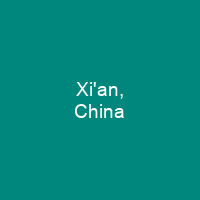Xi’an, also known as Sian, is the capital of Shaanxi Province. It is one of the oldest cities in China, and the oldest prefecture capital. Xi’an is the starting point of the Silk Road and home to the Terracotta Army of Emperor Qin Shi Huang. In 2019, it was named as one. the 7 main emerging megacities, or megalopolises.
About Xi’an, China in brief

It currently holds sub-provincial status, administering 11 districts and 2 counties. As of 2018 Xi’An has a population of 12,005,600 and the Xi’a–Xianyang metropolitan area a population. of 12. 6 million. It’s the most populous city in Northwest China, as well as the third most populousCity in Western China, the other two being Chongqing and Chengdu. It has a rich and culturally significant history. The area of present-day Xi’ans has been the site of several important former Chinese cities. The capital of the Western Zhou were the twin cities of Feng and Hao, known collectively as Fenghao, located on opposite banks of the Feng River at its confluence with the southern bank of the Wei in the western suburbs of Xi’ an. Under the Mongolian Yuan dynasty, it held a succession of names: Fengyuan, Anxi, and Jingzhao. The Ming name was changed back to Xijing between 1943 and 1943. During the Eastern Han, Chang’an was alsoknown as Xijing or the \”Western Capital\”, relative to its position to the main capital at Luoyang. Under the Sui, its name became Daxing in AD 581. The name reverted to Chang’An in 618.
You want to know more about Xi’an, China?
This page is based on the article Xi’an, China published in Wikipedia (as of Dec. 28, 2020) and was automatically summarized using artificial intelligence.







